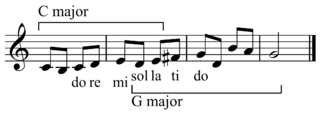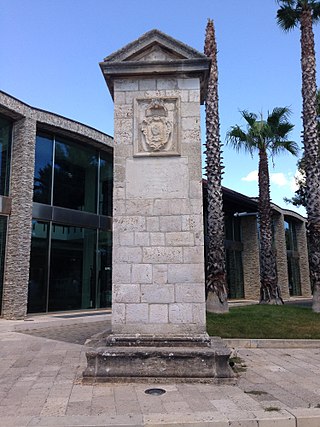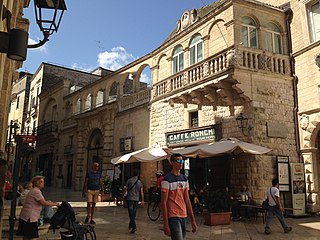The term blues scale refers to several different scales with differing numbers of pitches and related characteristics. A blues scale is often formed by the addition of an out-of-key "blue note" to an existing scale, notably the flat fifth addition to the minor pentatonic scale. However, the heptatonic blues scale can be considered a major scale with altered intervals.

In music, modulation is the change from one tonality to another. This may or may not be accompanied by a change in key signature. Modulations articulate or create the structure or form of many pieces, as well as add interest. Treatment of a chord as the tonic for less than a phrase is considered tonicization.
Modulation is the essential part of the art. Without it there is little music, for a piece derives its true beauty not from the large number of fixed modes which it embraces but rather from the subtle fabric of its modulation.

Altamura Cathedral, dedicated to the Assumption of the Blessed Virgin Mary, is a Roman Catholic cathedral in the city of Altamura, in the Metropolitan City of Bari, Apulia, in southern Italy.

Diatonic and chromatic are terms in music theory that are most often used to characterize scales, and are also applied to musical instruments, intervals, chords, notes, musical styles, and kinds of harmony. They are very often used as a pair, especially when applied to contrasting features of the common practice music of the period 1600–1900.

Édouard-Léon Scott de Martinville was a French printer, bookseller and inventor.
Dynamic tonality is a paradigm for tuning and timbre which generalizes the special relationship between just intonation and the harmonic series to apply to a wider set of pseudo-just tunings and related pseudo-harmonic timbres.

In physics, sound is a vibration that propagates as an acoustic wave, through a transmission medium such as a gas, liquid or solid. In human physiology and psychology, sound is the reception of such waves and their perception by the brain. Only acoustic waves that have frequencies lying between about 20 Hz and 20 kHz, the audio frequency range, elicit an auditory percept in humans. In air at atmospheric pressure, these represent sound waves with wavelengths of 17 meters (56 ft) to 1.7 centimeters (0.67 in). Sound waves above 20 kHz are known as ultrasound and are not audible to humans. Sound waves below 20 Hz are known as infrasound. Different animal species have varying hearing ranges.

Traditionally in Western music, a musical tone is a steady periodic sound. A musical tone is characterized by its duration, pitch, intensity, and timbre. The notes used in music can be more complex than musical tones, as they may include aperiodic aspects, such as attack transients, vibrato, and envelope modulation.
Declamation is an artistic form of public speaking. It is a dramatic oration designed to express through articulation, emphasis and gesture the full sense of the text being conveyed.

Francesco Fedeli, nicknamed Francesco Maggiotto or also il Maggiotto was an Italian painter from Venice.

The Epitaph of Altamura is a monument located in Altamura, Southern Italy. According to historian Ottavio Serena, it was erected right after the visit in city, on 8 April 1807, of Joseph Bonaparte, who had just become king of Naples. According to more recent hypotheses, this monument was instead built in the year 1797, right after the visit of the kings Ferdinand IV and Maria Carolina of Austria in the city of Altamura. The commemorative monument is located in largo Epitaffio. Although traditionally named epitaph, it is not a funerary inscription but instead a commemorative monument.

Luca de Samuele Cagnazzi was an Italian archdeacon, scientist, mathematician, political economist. He also wrote a book about pedagogy and invented the tonograph.

The Altamuran Revolution was a three-month period of self-government of Italian town Altamura, right after the birth of the Parthenopean Republic which ousted the Bourbons and the Kingdom of Naples. The city of the Kingdom of Naples was then defeated and taken by the so-called Sanfedisti, led by cardinal Fabrizio Ruffo, after a battle on the city walls. After being defeated, most Altamurans managed to flee through Porta Bari, one of Altamura's main gates.

Vitangelo Bisceglia was an Italian botanist, agronomist and professor. He taught inside the University of Altamura. Because of his being a polymath, he's been described as "an encyclopedic spirit, the honor of the Muses".

The Royal Society of Encouragement to Natural Sciences of Naples was a 19th-century learned society, established in the Kingdom of Naples during the rule of king Joseph Napoleon at the beginning of the 19th century. His activity, with different denominations, lasted until the first decades of the 20th century; it was officially closed in the 1930s, most likely in 1937. Its seat over the whole 19th century was Palace Spinelli di Tarsia, located in piazzetta Tarsia, Naples.

The University of Altamura was a former university located in Altamura, Apulia, Kingdom of Naples. It was established in Altamura in 1747 by Charles III of Bourbon, following the idea of the archpriest of Altamura Cathedral Marcello Papiniano Cusani. It was officially closed in 1812, mainly due to the lack of funds, even though some documents kept inside library Archivio capitolare in Altamura show that professors continued to teach until 1821.

The Liceo classico Luca de Samuele Cagnazzi is an Italian high school located in piazza Zanardelli 30, Altamura, Italy, close to the church Chiesa di San Domenico. It is named after Italian scientist Luca de Samuele Cagnazzi.
Giuseppe Carlucci was an Italian professor and astronomer. He was one of the first professors teaching at the University of Altamura (1747-1812).
Giuseppe de Samuele Cagnazzi was an Italian politician of the Kingdom of Naples. He was an inspector and director of the customs department of the Kingdom of Naples. He was the elder brother of Italian scientist and economist Luca de Samuele Cagnazzi.
The Bank of the Tavoliere di Puglia (1835-1845) was a bank located in the city of Foggia, in the Kingdom of the Two Sicilies. Its purpose was to foster the development of the so-called Tavoliere delle Puglie, one of the poorest areas of the Kingdom of the Two Sicilies, but its hidden purpose was probably to defraud Mr. Van-Aken, an investor from Bruxelles who was planning to invest about two million ducats in the Kingdom of the Two Sicilies on behalf of Dutch and Belgian bankers. As stated by Italian economist Luca de Samuele Cagnazzi, the purpose of all the banks in the Kingdom of the Two Sicilies was to commit some kind of bankruptcy fraud, leading to serious harm to the economy of the kingdom, and this was exacerbarted by widespread corruption in the field of justice.















